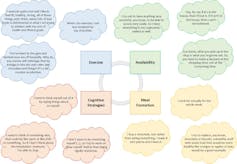It’s happened to most of us – we walk past a restaurant, cafe or bakery and something catches our attention. A delicious smell wafts out the door and our tastebuds start tingling. With so much cheap and easily accessible food in the Western world, it’s almost unavoidable. Sometimes we don’t even need to have seen or smelled a food to experience the intense desire to eat it, we can get cravings just from a thought crossing our minds.
Research has found that while resisting temptations like these can be very hard, people often do it for reasons such as health and fitness, finances, ethics and more. But what are the actual strategies that people use to refrain from eating every tasty morsel they see? For our latest study, we asked a group how they manage to stop themselves consuming tempting foods and drinks on a daily basis.
There is a wealth of advice available on how to manage food and drink intake. These range from the simple – for example, making a shopping list – to the extreme, such as cutting certain foods out of your diet completely. But our aim was to find out what people actually do to limit their consumption and if they find these strategies helpful.
Resisting tempting foods
We spoke to 25 people, who had an average age of 37 and BMIs of between 20 and 33 (healthy weight to obese). In a group discussion, we found that there were four major types of techniques that they used to manage their intake of tempting foods and drinks.
The first focuses on reducing the availability of tempting foods. Our participants said that they found it helpful to make tempting foods unavailable or difficult to access. They locked sweets away, for example, or would not have a store of them in their homes at all. Some of the participants made a shopping list, bought groceries for the whole week instead of every few days, or chose a supermarket with limited choices.
We also found that the study participants used different mental strategies to limit their intake. Some said they forbid themselves a certain food because once they start eating a small amount it leads them to eating a larger amount. Others took a more flexible approach, allowing themselves to have a treat but actively planning a certain time to eat it.
In addition, some participants told us how they use exercise as a strategy to manage their consumption of tempting foods. Some found that exercise reduced their hunger and desire to eat tempting foods, while other participants didn’t want to “undo their good work” by eating tempting foods.
Finally, the participants said that they managed their consumption by changing the formulation of their meals. The most frequently used strategies here included planning meals for a particular time, and making the food themselves. They said it is important for them to be able to choose the ingredients going into a meal, the portion size, and the time they eat it.
In addition to these four themes, we also found that the participants did not use the strategies in isolation. They used them together to help resist temptation in the moment and/or avoid being tempted in the first place, too. These strategies were not only used by people who identified themselves as active dieters either – the participants with BMIs in the healthy range also regularly employed them to manage their eating.
Ultimately, these findings show that there is no one way that people can easily manage food consumption. If we want people to be successful in reaching their goal of managing their intake of tempting foods and drinks – whatever their motivation may be – then the above strategies can help them.
But changes to the environment can also offer a helping hand. One example of this is stocking workplace vending machines with healthier options. In reality, there is unlikely to be a quick and easy way to change our environment, but efforts to make healthier options more accessible are a good place to start. People need to be able to go about their day without having to constantly manage temptation in response to ever present reminders of tasty foods and drinks.
Jennifer Gatzemeier, PhD Researcher in Behavioural Psychology, Swansea University; Laura Wilkinson, Lecturer in Psychology, Swansea University; Menna Price, Lecturer in Psychology, Swansea University, and Michelle Lee, Professor of Psychology, Swansea University
This article is republished from The Conversation under a Creative Commons license. Read the original article.


